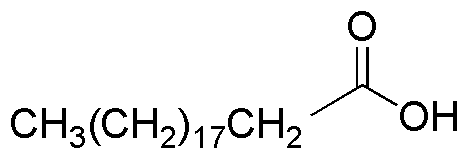Arachidic acid is widely utilized in research focused on:
- Food Industry: Arachidic acid serves as a food additive and stabilizer in various products, enhancing texture and shelf life.
- Cosmetics and Personal Care: This compound is used in lotions and creams for its emollient properties, providing moisture and improving skin feel.
- Pharmaceuticals: It acts as a lubricant and excipient in drug formulations, aiding in the delivery of active ingredients.
- Biotechnology: Arachidic acid is involved in the synthesis of biofuels and biodegradable plastics, contributing to sustainable practices.
- Research Applications: It is used in studies related to lipid metabolism and cell membrane dynamics, helping researchers understand biological processes.
General Information
Properties
Safety and Regulations
Applications
Arachidic acid is widely utilized in research focused on:
- Food Industry: Arachidic acid serves as a food additive and stabilizer in various products, enhancing texture and shelf life.
- Cosmetics and Personal Care: This compound is used in lotions and creams for its emollient properties, providing moisture and improving skin feel.
- Pharmaceuticals: It acts as a lubricant and excipient in drug formulations, aiding in the delivery of active ingredients.
- Biotechnology: Arachidic acid is involved in the synthesis of biofuels and biodegradable plastics, contributing to sustainable practices.
- Research Applications: It is used in studies related to lipid metabolism and cell membrane dynamics, helping researchers understand biological processes.
Documents
Safety Data Sheets (SDS)
The SDS provides comprehensive safety information on handling, storage, and disposal of the product.
Product Specification (PS)
The PS provides a comprehensive breakdown of the product’s properties, including chemical composition, physical state, purity, and storage requirements. It also details acceptable quality ranges and the product's intended applications.
Certificates of Analysis (COA)
Search for Certificates of Analysis (COA) by entering the products Lot Number. Lot and Batch Numbers can be found on a product’s label following the words ‘Lot’ or ‘Batch’.
*Catalog Number
*Lot Number
Certificates Of Origin (COO)
This COO confirms the country where the product was manufactured, and also details the materials and components used in it and whether it is derived from natural, synthetic, or other specific sources. This certificate may be required for customs, trade, and regulatory compliance.
*Catalog Number
*Lot Number
Safety Data Sheets (SDS)
The SDS provides comprehensive safety information on handling, storage, and disposal of the product.
DownloadProduct Specification (PS)
The PS provides a comprehensive breakdown of the product’s properties, including chemical composition, physical state, purity, and storage requirements. It also details acceptable quality ranges and the product's intended applications.
DownloadCertificates of Analysis (COA)
Search for Certificates of Analysis (COA) by entering the products Lot Number. Lot and Batch Numbers can be found on a product’s label following the words ‘Lot’ or ‘Batch’.
*Catalog Number
*Lot Number
Certificates Of Origin (COO)
This COO confirms the country where the product was manufactured, and also details the materials and components used in it and whether it is derived from natural, synthetic, or other specific sources. This certificate may be required for customs, trade, and regulatory compliance.

